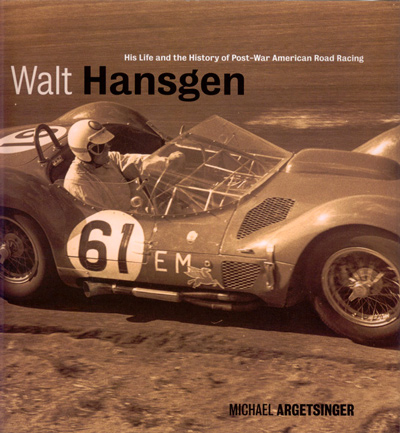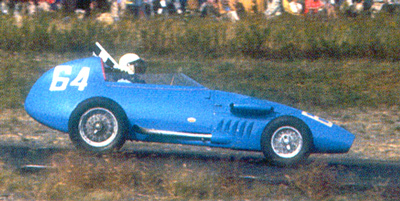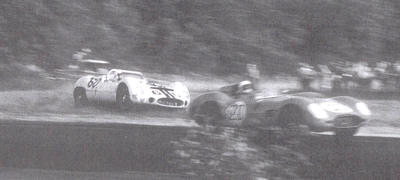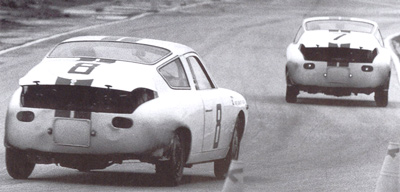July 12th, 2006
Walt Hansgen; His Life and the
History of Post-War
American Road Racing
Written by Michael Argetsinger
Review by Michael T. Lynch

The book's cover shows Walt Hansgen on his way to winning the under-two-liter class at the Times Grand Prix at Riverside in 1960. The car is Briggs Cunningham's Maserati T60 Birdcage.
|
Michael Argetsinger has written a towering biography of Walt Hansgen. The owner of a New Jersey body shop and a Jaguar dealer, Hansgen was the lead driver in the Briggs Cunningham team from 1956 until Briggs withdrew from racing at the end of the 1963 season. Hansgen's career continued with other teams, primarily that of John Mecom, until he was killed in a factory Ford Mk II at Le Mans practice days in 1966.
Cunningham's team stood above all others in the East, both in tenure and preparation, but that doesn't diminish Hansgen's achievements. Among them were his four SCCA National Championships in C Modified, then the most competitive and fastest class in North American road racing. In 1958, Walt went to England and beat the locals in three out of the four races he ran. When he qualified at Indianapolis in 1964, he was the fastest of any previous rookie (at 44 yrs old) and ran as high as third. In the 1965 500, he took his car from 21st on the grid to 5th before overheating slowed him. He had two 3rds in the two NASCAR Grand National events he competed in, and won 106 races of all kinds.

Walt Hansgen tours Watkins Glen in 1959 with the checkered flag after posting the first win by a Formula Junior car in America. Briggs Cunningham provided the Stanguellini.
|
Although Hansgen's career was primarily spent in the Northeast in British cars, he also had his successes in Italian marques. He had one-off rides in a Ferrari Monza and an OSCA MT4 in 1955, but those were the only Italian cars he drove in the first eight seasons of his career. He was in the first Formula Junior car to appear in America, a Stanguellini with an oversize engine, which raced as an exhibition-only car before the SCCA recognized the class. Walt used the same car to post the first win by an FJ in the country at Watkins Glen in 1959.

The denouement of the 1961 Watkins Glen Grand Prix arrives, as Walt Hansgen runs wide on the last lap in the Cunningham rear-engine Birdcage Maserati, allowing George Constantine in John Bunch's Ferrari 250 TR to edge through for the win.
|
In early 1960, Walt went to Modena to test Briggs Cunningham's new Tipo 61 Maserati Birdcage. Cunningham and his business partner and racing team manager, Alfred Momo, were becoming Eastern distributors for Maserati and had good factory entr�e. Hansgen used the Birdcage to win seven SCCA Nationals over the 1960-61 seasons. In 1960, he also drove Cunningham's T60 2-liter Birdcage to win the under two-liter class at the Los Angeles Times Grand Prix at Riverside. In 1961, the Cunningham team was also running the newer Tipo 63 rear-engine Birdcage. Its lack of factory development proved troublesome, but Hansgen posted the car's only wins in SCCA Nationals at Bridgehampton and the Elkhart Lake 500, with Augie Pabst co-driving in the latter. The next year Cunningham had both the supposedly improved rear-engine Tipo 164 Birdcage and the brutal front-engine Maserati 151 coupe with a 4-liter V-8. Walt was unable to produce any wins with either car.
The 1963 season saw the Maseratis on the sidelines, save a lone outing by a Tipo 64 at Watkins Glen. It was now fitted with a 289 Ford V-8. By the end of the season, Cunningham's team quit racing, but Walt landed with the Texas-based John Mecom team.

At Sebring in 1962, a round of the World Manufacturers Championship for small GTs was held. Briggs Cunningham entered two Fiat-Abarth 1000s. Walt Hansgen (8) chased Bruce McLaren the entire distance, but couldn't catch him. McLaren won the race, with Walt second.
|
Before joining Mecom, Hansgen drove a Ferrari GTO at Daytona for Luigi Chinetti's North American Racing Team. In September, Mecom took delivery of a new Ferrari 250 LM and Hansgen drove it to victory in the Elkhart Lake 500, again with Augie Pabst. He drove the same car at Nassau in 1964 and Sebring in 1965. Those drives, along with NART outings in a Ferrari 275 P at Mosport in 1964 and a 330 P at Daytona in 1965 would be Walt's last in Italian equipment. While his victories in Stanguellinis, Maseratis and Ferraris were a small part of his resume, they included some historic precedents and important races and contributed to the tradition of Italian race cars in America.
Mike Argetsinger's father was the founder of the races at Watkins Glen and the author sets Walt's spectacular career against the background of the development of the governance of top line U.S. road racing, from its revival at Watkins Glen as a purely amateur endeavor, until Hansgen's death, by which time it had been completely professionalized.
This is an insider's view of both Walt's life and the development of our sport in the U.S.A. This period is supposedly within my area of expertise, but Argetsinger has dug deeper here than anyone before him. If you have an interest in 1950s US road racing, one of its biggest stars and it's rough and tumble passage to professionalism, this is a must read. The book is available from David Bull Publishing, or 602 852-9500.



